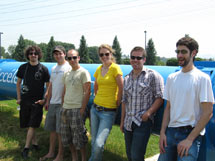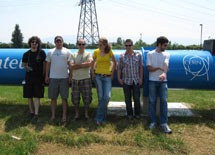
Handy Links
SLAC News Center
SLAC Today
- Subscribe
- Archives: Feb 2006-May 20, 2011
- Archives: May 23, 2011 and later
- Submit Feedback or Story Ideas
- About SLAC Today
SLAC News
Lab News
- Interactions
- Lightsources.org
- ILC NewsLine
- Int'l Science Grid This Week
- Fermilab Today
- Berkeley Lab News
- @brookhaven TODAY
- DOE Pulse
- CERN Courier
- DESY inForm
- US / LHC
SLAC Links
- Emergency
- Safety
- Policy Repository
- Site Entry Form

- Site Maps
- M & O Review
- Computing Status & Calendar
- SLAC Colloquium
- SLACspeak
- SLACspace
- SLAC Logo
- Café Menu
- Flea Market
- Web E-mail
- Marguerite Shuttle
- Discount Commuter Passes
-
Award Reporting Form
- SPIRES
- SciDoc
- Activity Groups
- Library
Stanford
Around the Bay
People: A Summer Exploring SLAC Research at CERN
There is an office on the campus of the European Nuclear Research Facility, CERN, that bears the SLAC logo. The red letters are a token of team spirit put forth by the far-from-home SLACers who work there. The room itself is long and narrow, and is bordered by what seems to be a single, lengthy table. Seven people normally share the office: one SLAC staff member, four postdocs and two graduate students. SLAC physicist Charlie Young, one of the SLAC ATLAS group leaders, makes eight. He isn't located at CERN full time, but he's there often enough that conditions in the office are considered snug.
So when three new Stanford University graduate students arrived at CERN—to attend the summer session that Young and his SLAC-based colleague Dong Su have organized for the past five summers—the result was an office so crowded that people often sat in whatever desk space was available. Bad as it may sound, it was a blessing in disguise for the summer graduate students. The close quarters encouraged conversation between the students and the other SLACers, rather than keeping talk limited to occasional meetings.
"Sometimes it's not the person you ask who knows the answer to something, but the person who overhears your discussion," said Max Swiatlowski, one of the visiting summer students, who begins his first semester at Stanford this month. "Having feedback and response available all the time was great."
Swiatlowski and fellow first-year student Spencer Gessner have yet to decide what their respective theses will address. Stanford gives graduate students the opportunity to work with different groups connected to the physics department before they decide which one to join. In an effort to recruit students into the SLAC family, Su and Young welcome undecided students to participate in the summer program. They were also joined by Katie Malone, who is starting her second year of graduate school at Stanford this semester, and will write her thesis with the ATLAS group. She plans to return to CERN for an extended stay once she completes her class work. While Malone was more or less sure of what she wanted to do in graduate school, Swiatlowski and Gessner say they chose Stanford partly because the school gave them the opportunity to explore their options. According to Young, this is quite common.
"It helps [the first year students] decide if this is what they want," Young said. "Many of them have done part-time research, but that's not the same as working on something eight hours a day, or 12 hours a day. Frankly, sometimes the students don't stay with us because maybe they realize, 'This isn't for me after all.' And that's good. Better to know early than late."
On the other hand, some students decide it is what they want. Bart Butler and David Miller, two of the SLAC graduate students stationed at CERN long-term, were two of the first to participate in the summer program at CERN.
Due to the weighty consequences of a student's decision to commit to one group, Young doesn't go easy on the visiting students. Swiatlowski and Gessner worked on software and hardware projects of real consequence to the group, and Young and Su insisted they attend various meeting each week, where the visiting students could meet and interact with many people. On his return to the U.S., Swiatlowski reflected on his experience juggling both hardware and software projects, and becoming part of the CERN community.
"I feel that at this point I can really understand what it means to work on ATLAS, and a lot of that is due to the way Charlie and Su Dong organized this summer," he said. "Having two full projects on my plate may have made my life a lot more difficult at times, but it allowed me to feel what full-time grad students and researchers feel: you're always balancing a thousand different obligations on an experiment this large. At the end of the day, I didn't feel like a summer student or something temporary, but instead like a real member of the group and experiment, and I think that that was very helpful in helping me figure out what I want to do in the future."
—Calla Cofield
SLAC Today, September 8, 2010

